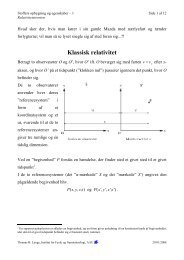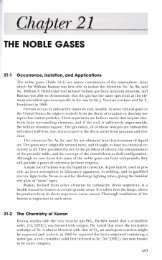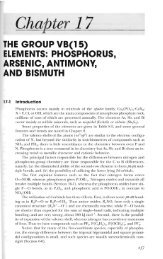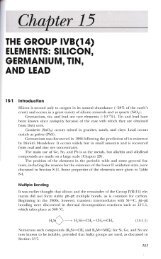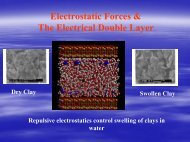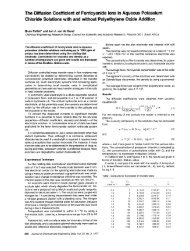Non-DLVO, steric and fluctuation forces
Non-DLVO, steric and fluctuation forces
Non-DLVO, steric and fluctuation forces
Create successful ePaper yourself
Turn your PDF publications into a flip-book with our unique Google optimized e-Paper software.
Solvation, Structural <strong>and</strong>Hydration ForcesChapter 13
<strong>Non</strong>-<strong>DLVO</strong> Forces• When two surfaces or particles approach closer than a fewnanometres, continuum theories of van der Waals <strong>and</strong> double– layer <strong>forces</strong> often fail to describe their interaction.• This is either because one or both of these continuum theoriesbreaks down at small separations or because other non-<strong>DLVO</strong><strong>forces</strong> come into play.• Solvation <strong>forces</strong> depend not only on the properties of theintervening medium but also on the chemical <strong>and</strong> physicalproperties of the surfaces.
Molecular Ordering at Surfaces, Interfaces <strong>and</strong>in Thin Films• The short-distance intermolecular pair potential can be quitedifferent from that expected from continuum theories.• The short-distance interactions are usually referred to assolvation <strong>forces</strong>, structural <strong>forces</strong>, or – when the medium iswater – hydration <strong>forces</strong>.• The solvation (or structuring) of solvent molecules at a surfaceis determined primarily by the geometry of molecules <strong>and</strong> howthey can pack around a constraining boundary.
Density profile
Origin of Main type of Solvation Force : TheOscillatory Force• The repulsive double – layer pressure between two chargedsurfaces separated by a solvent containing the surfacecounterions is given by the contact value theorem.P(D) = kT [ ρ s (D) - ρ s (∞)] (13.4)• This equation also applies to solvation <strong>forces</strong> so long as thereis no interaction between the walls <strong>and</strong> liquid molecules.• A solvation force arises once there is a change in the liquiddensity at the surfaces as they approach each other.
How the molecular ordering changes as theseparation D changes
Origin of Main type of Solvation Force : TheOscillatory Force• It is important to note that it is more correct to think of thesolvation force as the van der Waals force at small separationswith the molecular properties <strong>and</strong> density variations of themedium taken into account.• It is also important to appreciate that solvation <strong>forces</strong> do notarise simply because liquid molecules tend to structure intosemi-ordered layers at surfaces. They arise because of thedisruption or change of this ordering during the approach of asecond surface. If there were no change, there would be nosolvation force.
Measurements <strong>and</strong> Properties of SolvationForces: Oscillatory <strong>forces</strong> in <strong>Non</strong>-AqueousLiquids.• While theoretical work relevant to practical systems is still inits infancy, there is a rapidly growing literature onexperimental measurements <strong>and</strong> other phenomena associatedwith solvation <strong>forces</strong>.• The oscillations can be smeared out if the molecules areirregularly shaped, e.g., branched, <strong>and</strong> therefore unable to packinto ordered layers.
Measurements <strong>and</strong> Properties of SolvationForces: Oscillatory <strong>forces</strong> in <strong>Non</strong>-AqueousLiquids.• (1) Inert, spherical, rigid molecules : In liquids such as CCl 4 ,benzene, toluene, <strong>and</strong> cyclohexane whose molecules areroughly spherical <strong>and</strong> fairly rigid ⇒ the periodicity of theoscillatory force is equal to the mean molecular diameter σ.• (2) Range of oscillatory <strong>forces</strong> : The peak - to - peakamplitudes of the oscillations show a roughly exponentialdecay with distance with a characteristic decay length of 1.2 to1.7 σ.
Measurements <strong>and</strong> Properties of SolvationForces: Oscillatory <strong>forces</strong> in <strong>Non</strong>-AqueousLiquids.• (1) Inert, spherical, rigid molecules : In liquids such as CCl 4 ,benzene, toluene, <strong>and</strong> cyclohexane whose molecules areroughly spherical <strong>and</strong> fairly rigid ⇒ the periodicity of theoscillatory force is equal to the mean molecular diameter σ.• (2) Range of oscillatory <strong>forces</strong> : The peak - to - peakamplitudes of the oscillations show a roughly exponentialdecay with distance with a characteristic decay length of 1.2 to1.7 σ.
Measurements <strong>and</strong> Properties of SolvationForces: Oscillatory <strong>forces</strong> in <strong>Non</strong>-AqueousLiquids.• (3) Magnitude of <strong>forces</strong> : The oscillatory force can exceed thevan der Waals force at separations below five to 10 moleculardiameters, <strong>and</strong> for simple ( non-polymeric) liquids, mergeswith the continuum van der Waals or <strong>DLVO</strong> force at largerseparations.• (4) Effect on adhesion energy : The depth of the potential wellat contact (D=0) corresponds to an interaction energy that isoften surprisingly close to the value expected from thecontinuum Lifshitz theory of van der Waals <strong>forces</strong> (Section11.10).
Measurements <strong>and</strong> Properties of SolvationForces: Oscillatory <strong>forces</strong> in <strong>Non</strong>-AqueousLiquids.• (5) Effects of water <strong>and</strong> other immiscible polar components :The presence of even trace amounts of water can have adramatic effect on the solvation force between two hydrophilicsurfaces across a non-polar liquids. This is because of thepreferential adsorption of water onto such surfaces thatdisruptsthe molecular ordering in the first few layers. (Section15.6)• (6) Small flexible (soft) molecules :Their short-range structure<strong>and</strong> oscillatory solvation force does not extend beyond two tofour molecules.
Measurements <strong>and</strong> Properties of SolvationForces: Oscillatory <strong>forces</strong> in <strong>Non</strong>-AqueousLiquids.• (7) Linear chain molecules : Homologous liquids such as n-octane, n-tetradecane <strong>and</strong> n-hexadecane exhibit similaroscillatory solvation force laws. For such liquids, the period ofthe oscillations is about 0.4nm.• (8) <strong>Non</strong> – linear (asymmetric) <strong>and</strong> branched chain molecules :The liquid film remains disordered or amorphous <strong>and</strong> the forcelaw is not oscillatory but monotonic.
Measured force laws between mica surfaces
Measurements <strong>and</strong> Properties of SolvationForces: Oscillatory <strong>forces</strong> in <strong>Non</strong>-AqueousLiquids.• (9) Effect of moleular polarity (dipole moment <strong>and</strong> H-bonds) :The measured oscillatory solvation force laws for polar liquidsare not very different from those of non-polar liquids ofsimilar molecular size <strong>and</strong> shape.• (10) Effect of surface structure <strong>and</strong> roughness : The structureof the confining surfaces is just as important as the nature ofthe liquid for determining the solvation <strong>forces</strong>. As we haveseen, between two surfaces that are completely smooth (orunstructured) the liquid molecules will be induced to order intolayers, but there will be no lateral ordering within the layers. Inother words, there will be positional ordering normal but notparallel to the surfaces.
Measurements <strong>and</strong> Properties of SolvationForces: Oscillatory <strong>forces</strong> in <strong>Non</strong>-AqueousLiquids.• However, if the surfaces have a crystalline (periodic)lattice, this will induce ordering parallel to thesurfaces as well, <strong>and</strong> the oscillatory force will nowalso depend on the structure of the surface lattices.• On the other h<strong>and</strong>, for surfaces that are r<strong>and</strong>omly rough, theoscillatory force becomes smoothed out <strong>and</strong> disappearsaltogether, to be replaced by a purely monotonic solvationforce.
Solvation of Forces in Aqueous Systems:Repulsive ‘Hydration’ Forces• There are many other aqueous systems where <strong>DLVO</strong> theoryfails <strong>and</strong> where there is an additional short-range force that isnot oscillatory but smoothly varying, i.e., monotonic.→exponentially repulsive b/n hydrophilic surfaces : repulsivehydration or structural force(whenever water molecules strongly bind to surfaces containinghydrophilic groups or H-bonding groups)Strength : E needed to disrupt the H-bonding network <strong>and</strong>/ordehydrate two sufaces
Two types ofRepulsive ‘Hydration’ Forces (1)• Steric hydration <strong>forces</strong> b/n fluid-like amphiphilic surfaces Measured across soap films composed of various surfactant monolayersas well as across uncharged bilayers composed of lipids withzwitterionic or sugar headgroups Force range : 1-2 nm, Exponential decay length : 0.1-0.3 nm; both increase with the temp. <strong>and</strong> ‘fluidity’ of highly mobileamphiphilic structures Origin of this force : entropic-arising from overlap of thermally excitedchains <strong>and</strong> headgroups protruding from these surfaces (CH 14 &18)
Two types ofRepulsive ‘Hydration’ Forces (2)• Repulsive hydration <strong>forces</strong> b/n solid crystalline hydrophilicsurfaces In the case of silica, mica, certain clays <strong>and</strong> many hydrophilic colloidalparticles Arising from strongly H-bonding surface group (hydrated ions or –OH)→ Relatively long-range force (Force range: 3-5nm, decay length: 1nm) Empirical relation of the hydration repulsionW=+ Wλ 0 ≈0.6-1.1 nm for 1:1 electrolytesW 0 < 3-30 mJ/m-20e−D/ λ0Between two silica surfaces invarious aqueous NaCl solutions
Two types ofRepulsive ‘Hydration’ Forces (2)Measured <strong>forces</strong> b/n curved micasurfaces in KNO 3 or KCl solutionsForce range : 3-4 nm, Exponentialdecay length : 1 nm, Short-rangeoscillations of periodicity 0.22-0.26 nm In dilute electrolyte solutions (10 -3 ) hydrated cations bind to the negativelycharged surfaces <strong>and</strong> give rise to a repulsive hydration force→ the strength <strong>and</strong> range of the hydration <strong>forces</strong> increase with the hydrationnumber of cations : Mg 2+ > Ca 2+ > Li + ∼ Na + > K + > Cs +c.f.) acid solution : only proton ions
Two types ofRepulsive ‘Hydration’ Forces (2)Measured short-range <strong>forces</strong> b/ncurved mica surfaces in 10 -3 M KClsolutionsThe expected <strong>DLVO</strong> interaction Exhibiting oscillations of mean periodicity of 0.25±0.03 nm, roughly equal tothe diameter of the water molecule, below about 1.5 nm The first three minima at D≈0, 0.28 <strong>and</strong> 0.56nm at negative energies Clay plates such as motomorillonite : repelling each other increasingly stronglydown to separations of ~2 nm vs. stacking into stable aggregates with waterinterlayers of 0.25 <strong>and</strong> 0.55 nm thickness
Two types ofRepulsive ‘Hydration’ Forces (2)• Hydration <strong>forces</strong> can be modified or regulated by exchangingions of different hydrations on surfaces Hydration regulation in colloidal dispersions : the effects of differentelectrolytes on the hydration <strong>forces</strong> b/n colloidal particles can determinewhether they will coagulate or notDomains of stability <strong>and</strong> instability ofamphoteric PS latex particles, composedof –COO – <strong>and</strong> –NH 3+ groups in (a)CsNO 3 <strong>and</strong> (b) KNO 3(b) is more stable due to thestronger hydration of K + than Cs +
Two types ofRepulsive ‘Hydration’ Forces (2)• The effectiveness of cation as coagulants decreases accordingto ‘lyotropic series’Cs + > K + > Na + > Li + , Ca 2+ > Mg 2+ Computer simulation of interaction b/n alkali metal <strong>and</strong> chloride ionsdepth of the primary potential minimum : Li + Cl - > Na + Cl - > K + Cl - The repulsion in water : K + -K + > Na + -Na + > Li + -Li +• Repulsive hydration <strong>forces</strong> can be used as follows Unexpectedly thick wetting films of water on silica (ch 12.9) Clay swelling, ceramic processing <strong>and</strong> rheology, <strong>and</strong> colloidal <strong>and</strong>bubble coalescence
The intrinsic nature of hydration force• The hydration force is not of a simple nature It is probably the most important yet the least understood of all the<strong>forces</strong> in liquids The nature of the surfaces is equally important : ion exchange (addingmore salt or changing the pH for hydrophobic surface, chemicalmodifying for hydrophilic surface)• How do exponentially decaying hydration <strong>forces</strong> arise? A monotonic exponential repulsion or attraction, possibly superimposedon an oscillatory profile ; simply additive with the monotonic hydration<strong>and</strong> <strong>DLVO</strong> <strong>forces</strong> with different mechanisms. The short-range hydration force b/n all smooth, rigid or crystallinesurfaces has an oscillatory components.
Solvation of Forces in Aqueous Systems:Attractive ‘Hydrophobic’ Forces• A hydrophobic surface cannot bind to water molecules via ionicor hydrogen bonds ; entropically unfavorable !!→ attractive force b/n hydrophobic surfaces (hydrocarbon<strong>and</strong> fluorocarbons)• Accumulated experimental data of this force Mica surfaces coated with surfactant monolayers exposing hydrocarbonor fluorocarbon groups Silica <strong>and</strong> mica surfaces with rendered hydrophobic by chemicalmethylation or plasma etching→ the hydrophobic force law b/n two macroscopic surfaces is ofsurprisingly long range, decaying exponentially with a decay length of 1-2nm in the range 0-10nm, hydrophobic force >> van der Waals attraction
Examples of attractive hydrophobic interactions inaqueous solutions(a) Low solubility/immiscibility (CH15,16)(b) Micellization (CH 16)(c) Dimerization <strong>and</strong> association ofhydrocarbon chains(d) Protein folding(e) Strong adhesion(f) non-wetting of water on hydrophobicsurfaces(g) Rapid coagulation of hydrophobic orsurfactant-coated surfaces(h) Hydrophobic particle attachment torising air bubbles
Solvation of Forces in Aqueous Systems:Attractive ‘Hydrophobic’ Forces• Attractive hydrophobic <strong>forces</strong>[AHF] can be judged frommeasurements of their interfacial energy with water γ i or fromthe contact angle of water on them(CH 15)W= −2γe −D/ λ0iin the range 0-10 nm, γ i = 10-50 mJm -2 , λ 0 = 1-2 nm• D < 10nm, AHF is insensitive or only weakly sensitive toelectrolyte ions <strong>and</strong> their conc.D > 10nm, AHF does depend on the intervening electrolyte, <strong>and</strong>that in dilute solutions, or solutions containing divalent ions, itcan continue to exceed the vdWs attraction out to separation of80nm.
Solvation of Forces in Aqueous Systems:Attractive ‘Hydrophobic’ Forces• The origin of the hydrophobi force is still unknownMonte Carlo simulation of the interaction b/ntwo hydrophobic surfaces across 1.5nm water→ Decaying oscillatory force !• Hydrocarbon/ethylene-oxide interface From being strongly hydrophilic (top curve)to strongly hydrophobic (bottom curve) Increasingly more hydrophobic at highertemp. The hydration force can be far stronger thanAny of the <strong>DLVO</strong> <strong>forces</strong>.Example of increasing attraction with temperaturecharacteristic of hydrophobic <strong>forces</strong>
Chapter 14.Steric <strong>and</strong> Fluctuation ForcesChapter 14.
Diffuse InterfaceDiffuse surface = Dynamically rough (thermally mobile surface groups)Liq. 1Liq. 2SurfaceSolventInherently mobile or fluid-likeSurfaceChain moleculesattached to a surface,dangled out into the solution polymer covered surface
What is a Polymer ?‣ Polymer :Macromolecule composed ofmany monomersHomopolymer : ~A-A-A-A~Copolymer : ~A-B-A-B~
Volume of PolymersUnperturbed R<strong>and</strong>om Coil‣ Unperturbed radius of gyration, R gMR gn = # of segmentsl = effective segment length,( Only in ideal solvent ! )‣ Flory radius, R F = α R g ln 3/5 (in real solvents)(α : Intermolecualr expansion factor)M 0lGood solvent : repulsion btw. segments (α 1)Theta temperature, T θ : ideal solvent (α =1)
Polymers at SurfacesIn solution ChemisorbedPhysisorbedLow coverage high coverage Bridging
Repulsive Steric Forces between Polymer-Coated SurfacesForce developmentprocessOuter segments overlap Repulsive <strong>steric</strong> forceFactors affecting<strong>steric</strong> force▶ Coverage of polymer on each surface▶ Reversible adsorption orirreversible grafting onto the surface▶ Quality of the solvent
Theories of Steric Interaction IConsider repulsive <strong>steric</strong> interaction between surfaces containing an adsorbedpolymer layerwhere each molecule is grafted at one end to the surface but is otherwise inert1) At low surface coverage▶ No overlap of neighboring chains▶ Each chain interact with the opposite surface independent of other chainsRepulsive energy per unit area for two surfaces in a theta solventover the distance from D=8R g down to D=2R gW(D)= 2ΓkTe2−D/ 4R2g −D/R g+ ... ≈ 36ΓkTeW(D)≈ 36kTe−D/R gper moleculeΓ : number of grafted chains per unit areaΓ = 1/s 2 (s: mean distance between attachment point)Valid for low coverage s > R gwhen layer thickness (L) is equivalent to R gln0L = Rg = = ∝6lM / M6M1/ 2▶ Layer thickness- In theta solvent : vary as M 0.5- In good solvent : vary as M 0.63/53/5 0.6L = RF = l ⋅ n = l ⋅( M / M0)∝ M
Theories of Steric Interaction II2) At high surface coverage (Brush)▶ Adsorbed or grafted chains close to each other Chains are forced to extend away from the surface much farther than R g▶ Brush Layer thickness- End-grafted chain : L M- General equation for brush in a theta solventL M υ n υ υ : 0.5 ~ 1 (from low to high coverage)- For a brush in a good solventL=nls5/ 32 / 3=Γ1/ 2 5/ 3R FΓ = 1/s 2R F = ln 3/5
Theories of Steric Interaction IIIAlex<strong>and</strong>er-de Gennes theory▶ Repulsive pressure between two brush-bearing surfaces closer than 2L44[( 2L/ D) ( ) ]9 /− D /3/kTP( D)≈2L3sfor D < 2LOsmotic repulsion between the coils favor stretching increase DElastic energy of the chain Oppose stretching Decrease D▶ For 0.2 < D/2L < 0.9,100kTP(D)≈3se100LW ( D)≈ kTe3πs−π⋅D/ L−πD/ L100kT=sΓe−π⋅D/ L100L= ΓkTeπs−πD/ LW = Fs
Steric <strong>forces</strong> between surfaces with end-grafted chains▶ End-grafted polymers : well understood- Each molecule is attached to the surface at one end- Coverage is fixed- Molecules do not interact either with each other or with the two surfaces- ex) Di-block copolymerOne block for anchoring, the other protruding into thesolvent to form polymer layerFig 14.3 Forces between twopolystyrene brush layers endgraftedonto mica surfaces intoluene▶ Measured <strong>forces</strong> agree with theoretical fits ofAlex<strong>and</strong>er - de Gennes eqn.▶ No hysterisis on approach <strong>and</strong> separation ofpolymers
Steric <strong>forces</strong> between surfaces withphysisorbed layers I▶ No anchoring group that chemisorb to the surface▶ Binding to the surface via much weaker physical <strong>forces</strong>▶ Highly dynamic layers: Individual segments continually attaching <strong>and</strong> detaching from the surface: whole molecules slowly exchange with those in bulk solutionWhen two surface approach each other▶ Amount of adsorbed polymer changing▶ Number of binding sites per molecule changing▶ Different segments from the same coil bound to both surfaces Bridging▶ Long time to reach equilibrium▶ Hysteretic force profile
Steric <strong>forces</strong> between surfaces with physisorbed layers IIEvolution of the <strong>forces</strong> with the timeallowed for high MW polymer to adsorbfrom solutionForces between two polyethylene oxidelayers physisorbed onto micaSolvent : aquous 0.1M potassium nitride▶ Hysterisis on approach <strong>and</strong> separationof physisorbed polymer▶ time ↑, adsorption ↑, brush layer ↑▶ Gradual reduction in the attractivebridging component▶ The range of repulsive <strong>steric</strong> force may be many times R g ( > 10 R g )
Forces in Pure Polymer Liquids (Polymer melts)▶ Polymer molecules are surrounded by molecules of its own kind Much the same interactions as that of a polymer in a thetasolvent▶ Terminally anchored to the surfaceW ( D)W ( D)=≈2ΓkTe36kTe−D2− D // 4R gR2g −D/ R g+ ...≈ 36ΓkTe
Experimental force behavior in Pure Polymer Liquid▶ Forces betweenmica surfaces acrosspure polymer melts▶ At small distance : Oscillations with a periodicity equal to the segment width▶ <strong>Non</strong>-equilibrium monotonically decaying repulsion farther out up to 10R g: Strong binding or effective immobilization of polymers at the surface▶ Forces between inert hydrocarbon surfacesacross chain-like hydorcarbon liquids▶ Forces between Irregularly shaped polymers(e.g. bumpy segments or r<strong>and</strong>omly branchedside group)▶ Attractive tail Much weaker binding to the surfaces▶ No short range oscillation,but smooth monotonic repulsion Inability to order into discrete, well-defined layers▶ Limitation of force measurement in polymer molecules concentrated within adsorbed surface layer orconfined within a thin film between two surfaces- Molecular relaxation time higher than in the bulk- Liquid molecules in the bulk freeze into amorphous glassy state at the surface Measurement not at true thermodynamic equilibrium
Attractive Intersegment Forces▶ Polymer segmentsSegments attract each other in a poor solvent : van der Waals force, solvation <strong>forces</strong>Isolated coil shrinks below R g in solution▶ Polymer-coated surfaces▶ As two polymer-coated surfaces come together in poor solvent,Attraction between the outermost segments Initial Intersegment attraction between surfaces▶ As two polymer-coated surfaces come closer,Steric overlap repulsion wins out
Attractive Intersegment Forces / Bridging <strong>forces</strong>(a) End-grafted polystyrenebrush in toluene (θ = 35 )(b) Physisorbed polystyrenein cyclohexane (θ = 34.5 )R g = 7 nmR g = 11 nmR g = 8.5 nmR g = 21 nmAttraction dueto intersegmentforceAttraction dueto BridgingforceAttraction dueto intersegmentforce▶ Interactions between grafted <strong>and</strong> adsorbed polystyrenelayers below the theta temperature in poor solvent
Attractive Bridging ForcesReuquirement► Segment – surface force : attractive► Available binding sites for segments on the opposite surfaceBridge formation► Polymer coil will form bridge between two surfaces Attractive bridging force between two surfacesDependenceon coverage► Coverage too high (brush), few free binding sites forbridges Brush layer thicker than R F , no bridging attraction► Coverage too low, density of bridges will be lowDependenceon distanceStrength► Bridging force decays exponentially with distanceDecay length ≈ R g of the tail <strong>and</strong>/or loops on the surfaces► under suitable conditions, Sometimes strong far exceedingvan der Waals interaction
Effect of surface coverage <strong>and</strong> solvent qualityBy polymer property(Reactivity, M.W. …)▶ Effect of surface coverage <strong>and</strong> solvent qualityon force profiles of adsorbed <strong>and</strong> grafted chains
Attractive Depletion Forces I▶ Polymers repelled from surfaces no adsorption from solution at all But weak attractive interactionConsider▶ Two surfaces in a dilute solution of coils of average radius Rg▶ Polymer coils have no interaction with the surfaceWhen surfaces are closer than Rg, coils will be pushed out from the gap Reduced polymer concentration between the surfaces▶ Bulk polymer concentration ρ,Applying contact value theorem : P(D) = kT [ρ s (D) – ρ s (∞)]Attractive depletion force per unit area between the surfaces at contactP (D→0) = - ρ kTDepletion free energy per unit areaW (D→0) ≈ - ρR g kTexample) ρ = 10 24 m -3 , R g = 5 nm T=25 Interaction energy between two surfaces decrease by 0.2 mJ/m 2 due to depletion
Attractive Depletion Forces II▶ Strong depletion force- High bulk concentration of polymer molecule (high ρ)-Large R g (high MW) Choose high polymer concentration (high ρ , low MW, low R g )▶ In the limit of very high ρ , low R g- Adhesive minimum becomes deeper- Range of depletion force decrease (low R g )- By the time polymer mole fraction reach unity, Characteristic of a pure liquid or polymer melt▶ Attractive depletion force- Explain colloidal particle coagulation
<strong>Non</strong>‐Equilibrium Aspects of PolymerInteractionsPolymer mediated interaction is not always in equilibrium !▶ Molecular relaxation mechanisms- Solvent has to flow out through the network of entangled polymer coils- Coils themselves must reorder as they become compressed- New binding sites <strong>and</strong> bridges have to be formed- A certain fraction of polymer molecules may have to enter or leave the gapregion altogether Concerted motions of many entangled molecules Require many hours or days (c.f. 10 -6 sec for isolated coils) Hysteresis, time-dependent effects
Thermal Fluctuation Forces between Fluid-like Surfaces▶ Thermally mobile or fluid-like surfaces- micelles, microemulsion droplets, biological membranes- constantly changing shapes- a number of repulsive ‘ thermal <strong>fluctuation</strong> ’- protrusion, undulation, peristaltic motionprotrusion Undulation <strong>forces</strong> Peristaltic <strong>forces</strong>
Protrusion Forces I▶ Approaching two amphiphilic surfaces (molecular - scale overlap)- protruding segments are forced into the surfaces- for grafted chain : remain between the surfaces-for adsorbed chain : forced out into the bulk liquid
Protrusion Forces II▶ Approximationenergy increase linearly with the distance z, that the moleculesprotrude into the waterProtrusion energyi i( μz − μ0)prot= πσzy = α p z Eq. (13.1)υ(z i ) = α p z i(α p : interaction parameter units , Jm -1 )The density of protrusion extending distance z from the surface−αz/ kTp i− ziρ( 0) e = ρ(0)e/ λλ = κT / α p( the protrusion decay length )
Protrusion Forces III▶ The protrusion force between two amphiphilic surfacesLateral dimension σExtending a distance z i into the solutionΓ protrusion sites per unit area,by potential distribution theorem (Eq. 4.9)The interaction free energyW ( D)= −ΓkTln{ ∫ dz2∫D D−Z2 2−αp D / kTexp[ −αp(z1+ z2)/kT]dz1}= −ΓkTln{( kT / αp)[1 − (1 + Dαp/ kT)e0 0]}Protrusion pressureP−αD / kT2p−D/ λ( ΓαpD/ kT ) eΓαp( D / λ)eD)= −∂W/ ∂D==(14.11)−αpD/ kT−Dλ[1 − (1 + α / ) ] [1 (1 D / λ)e ]pDkT e − +λ < D < 10 λ P(D) = 2.7 Г α pe -D/ λ (λ ≈ kT/α p) (14.12)(/D < λP( D → 0) = 2ΓkT/ D(14.13)
Protrusion Energy▶ Eq. (14.12) corresponds to an energy per unit areaW(D) = 2.7 Гα pλ e -D/ λ ≈ 3 Г kTe -D/ λ (14.14)▶ Compare with…W ( D)≈36ΓkTe−D/ Rs(end grafted chains)W ( D)≈30ΓkT(L/s)e−πD/ L(two brush layers)
Undulation <strong>and</strong> Peristaltic Forces IArise from the entropic confinement of their undulation <strong>and</strong>peristaltic waves as two membranes approach each other Derived from contact value theorem (entropic force per unit area)P(D) = kT[ρ s (D) – ρ s (∞)](ρ s : Volume density of molecules in contact with the surfaces)▶ Undulation force -Membrane’s bending modulus, k bIn thermally excited waves)The density of contactsρ ( D)= 1/( volume / mode)sρ ( ∞)= 0(14.15s= 1/ πx2DBy the ‘chord theorem’ Eq.(9.7) x 2 ≈2RDThe undulation pressurekTP D)=2πxDkT2πRD( ≈2(14.16)Elastic bending energy, E b of a curved membrane with local radii R 1 <strong>and</strong> R 221 ⎛ 1 1 ⎞2Eb = kb2kb/ R forR1R22⎜ + = − − − = =R1R⎟⎝ 2 ⎠R(14.17)
Undulation <strong>and</strong> Peristaltic Forces IIAt temperature T, suppose that each mode has area πx 2 & energy ~kTkT2 23≈ 2π x k / R = 4πDkR Eq. (14.16) P( D)≈ ( kT ) 2 / k Db b/bUndulation force can be drastically reduced or even eliminated !- when a membrane carries a surface charge- when it is in tension▶ Peristaltic force - Area expansion modulus, k a)Mean area, a = πx 2Exceeding surface area per mode, ∆a = πD 2Elastic energy E aEa=1K2a( Δa)a2=πka2xD24(14.19The peristaltic pressure22 2( kT )P( D)= kT / πxD ≈2 2π k Da(14.20)




